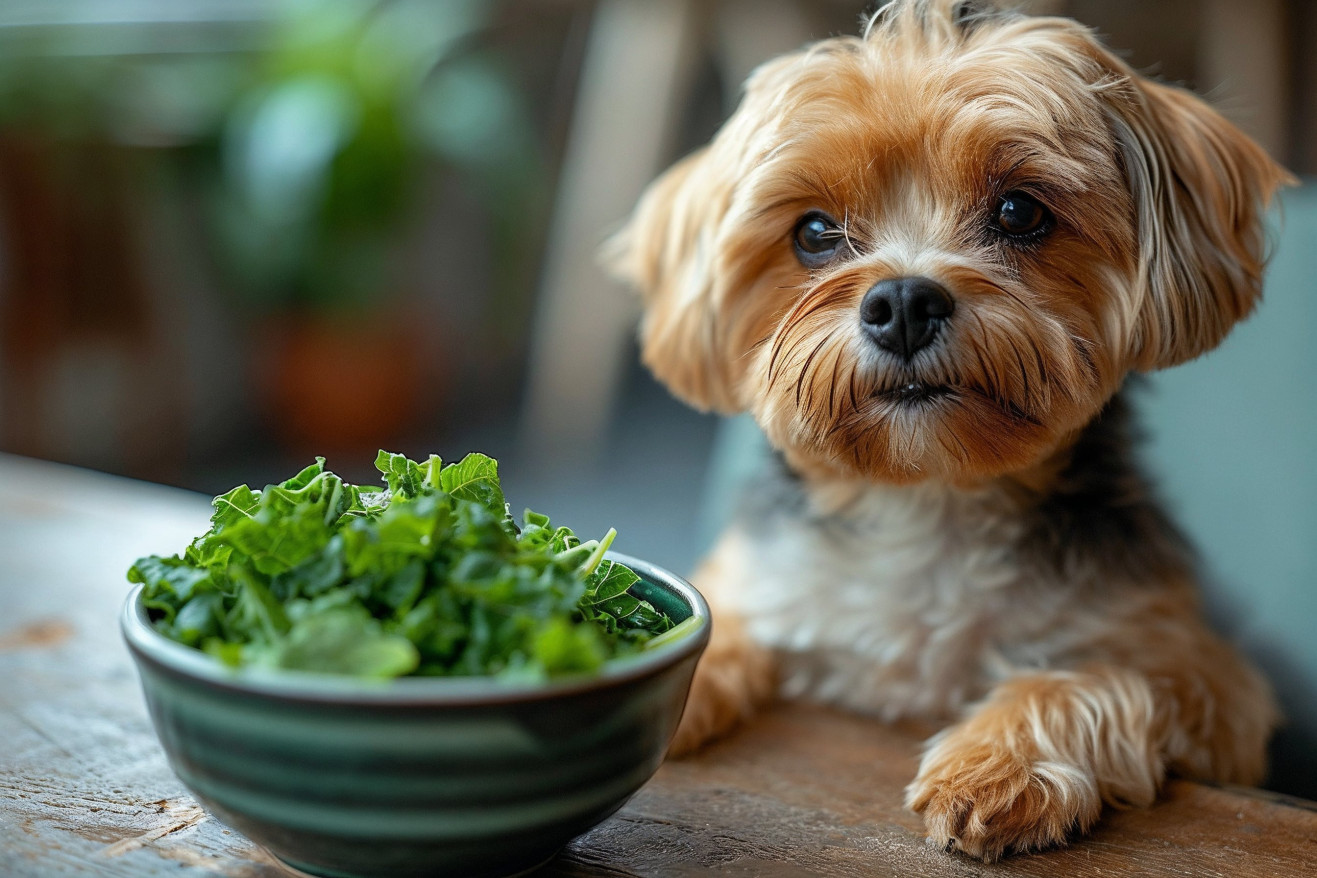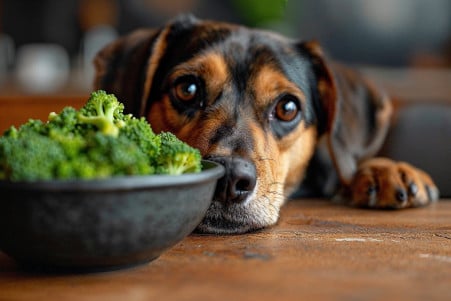Can Dogs Eat Collard Greens? How to Safely Feed Your Dog This Leafy Green
7 February 2024 • Updated 6 February 2024

Collard greens are a great source of nutrients for humans, but can the same be said for dogs? While collard greens aren’t toxic to dogs, they should only be fed to them in moderation. They should also be cooked and the stems should be removed.
Collard greens are full of vitamins and fiber, which can be good for dogs, but if your dog has kidney or bladder problems, you should talk to your vet before feeding them collard greens.
This article will look at the nutritional value of collard greens and how they can impact your dog’s health. It will review research from veterinarians, nutritional recommendations, and expert opinions to determine which parts of collard greens can be good for dogs and which can be bad.
By the end of this article, you’ll know exactly how to add collard greens to your dog’s diet in a way that will keep them safe and healthy.
Can dogs eat collard greens?
Nutritional Benefits of Collard Greens for Dogs
Collard greens are packed with nutrients that can help improve your dog’s health. The Food Revolution Network says that one cup of cooked collard greens contains important vitamins like A, C, and K1, and minerals like calcium and iron. Vitamin A helps the immune system and promotes eye health, while vitamin C is an antioxidant. Vitamin K1, which is abundant in collard greens, is important for blood clotting, according to Medical News Today.
One thing to be aware of with collard greens is that they are high in oxalates, which can block the absorption of minerals when consumed in large amounts. That said, Healthline explains that collard greens have lower oxalate levels than other leafy greens like spinach.
Still, a study from the National Institutes of Health warns that the high levels of vitamin K1 in collard greens should be monitored in dogs taking blood thinners due to potential drug interactions.
Overall, adding collard greens to your dog’s diet can help improve their health, as long as they are prepared and served in the right way.
How to Make Collard Greens Safe for Dogs
The key to feeding collard greens to your dog is in how you prepare them. DogTime says that you should cook collard greens before feeding them to your dog, as this will break down the leaves and make them easier for your dog to digest.
Steaming is the best way to cook the collard greens, as it will help them retain the most nutrients and won’t add any harmful ingredients. Just make sure to remove the stems, which are hard for dogs to digest and can cause an upset stomach.
Don’t add salt, garlic, or onion to the collard greens when you cook them for your dog, as these ingredients can be toxic to dogs. Stick with fresh, plain collard greens to be safe. A-Z Animals recommends that you also consider the size and activity level of your dog when determining how much to feed them. For small to medium dogs, start with less than half a cup a day and adjust from there.
Always talk to your vet, especially when you’re adding new foods to your dog’s diet. They can give you personalized recommendations about how to safely add collard greens to your dog’s diet so that they get the nutrients they need without any negative side effects. If you follow these tips, you can make sure that your dog gets all the benefits of collard greens as part of a healthy diet.
Essential Nutrients for Canine Health: What You Need to Know About Vitamins and Minerals in Dogs
Vitamins and minerals are essential for a variety of biological functions in dogs, ranging from supporting the immune system to promoting healthy bones.
A study posted in PMC shows that Vitamin A is important for vision and immune function in dogs, but it can also be toxic, especially in puppies.
This makes it important to have safe levels of the vitamin to avoid problems like joint pain and bone deformities.
Vitamin C is synthesized by dogs and is an important antioxidant that helps with cell growth and regulating the immune system, and it may even be helpful in life-threatening situations like sepsis, according to a review in PubMed.
Vitamin K is important for blood clotting and can be used to treat rodenticide poisoning. Meanwhile, calcium and iron, which are both found in collard greens, are important for bone health and oxygen transport, respectively. A study in PMC shows that iron is important for preventing anemia and maintaining metabolic processes.
This is why it’s important to make sure that these nutrients are in balance in a dog’s diet, as this can help prevent deficiencies and toxicities. When it comes to feeding dogs collard greens and other vegetables, it’s important to make sure that they are fed in moderation and that dogs are monitored for any potential side effects.
Vegetables in a Dog’s Diet: The Good and the Bad
Vegetables can be a great way to supplement your dog’s diet with vitamins, minerals, and fiber. The American Kennel Club lists carrots, celery, green beans, and cucumbers as some of the best vegetables for dogs because they are hydrating and nutritious while being low in calories. On the other hand, vegetables like onions and garlic are toxic to dogs and can cause a variety of health issues.
Collard greens can be a healthy part of a dog’s diet if they are prepared properly, including being cooked and having the stems removed.
Like other healthy vegetables, collard greens are full of nutrients but should be fed to dogs in moderation.
An article by PetMD explains that it’s important to make sure that vegetables are prepared properly and that they are served plain and cut into small pieces to avoid choking hazards. Meanwhile, an article in Forbes explains that while vegetables like collard greens can be a healthy snack, they should make up no more than 10% of a dog’s diet in order to ensure that they are getting all of the nutrients they need.
In short, many vegetables can be a great addition to a dog’s diet, but it’s important to make sure that they are fed in moderation to prevent nutritional imbalances. When it comes to collard greens, it’s important to make sure that they are prepared and portioned correctly to ensure that they have a positive impact on a dog’s health.
Health Risks: Isothiocyanates and Calcium Oxalate in Canine Diets
Despite the health benefits of collard greens for dogs, some of the compounds in collard greens mean that they should be fed to dogs with caution. The Linus Pauling Institute notes that isothiocyanates in cruciferous vegetables can lead to gastric irritation, and dogs that consume too many of these compounds can experience gastrointestinal upset.
Even more worrisome is the presence of calcium oxalate, which is linked to the formation of kidney and bladder stones. A study by Dr. Eva Furrow at the University of Minnesota College of Veterinary Medicine showed that certain breeds, including Miniature Schnauzers and Bichon Frises, are genetically predisposed to calcium oxalate urolithiasis, with a 20 times greater risk than mixed-breed dogs.
This means that it’s especially important to be on the lookout for urinary problems in these breeds. VCA Animal Hospitals explains that signs of urinary problems include blood in the urine and straining to urinate, which can be a sign that a stone is blocking the urinary tract.
In other words, while collard greens can be part of a dog’s diet, it’s important to feed them in moderation and be on the lookout for any problems that could indicate that they’re having a negative impact on your pet’s well-being.
Final Thoughts on Giving Dogs Collard Greens
To sum up, collard greens can be a nutritious addition to your dog’s diet, providing a range of important vitamins and minerals that can help with immune function, bone strength, and more.
Cooking collard greens is the best way to ensure that they are safe and easily digestible for dogs, and it’s important to make sure that no harmful ingredients are included in the cooking process. It’s also important to make sure that you’re not giving your dog too many collard greens, so that you can avoid any potential nutrient imbalances or digestive upset.
Always make sure to talk to your vet before giving your dog collard greens, especially if your dog has any preexisting health issues, such as kidney or bladder problems. Regular check-ins with your vet can help ensure that your dog’s diet is tailored to their needs and that you can avoid any potential issues.
When used in the right way and in the right context, vegetables can be a great way to add variety and important nutrients to your dog’s diet. In this context, collard greens can be a helpful part of a diet that is not only nutritionally complete but also helps to ensure that your dog is as healthy and happy as possible.


